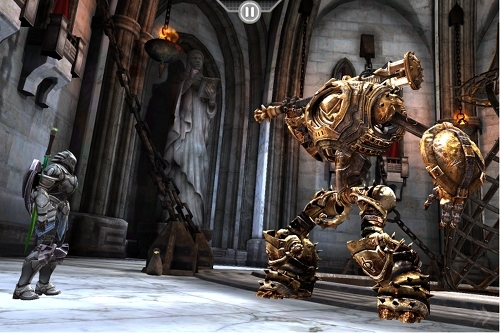
So the question is whether Infinity Blade is a full game release rather than a tech demo. The answer is that Infinity Blade is a “proper” game, but not a particularly big one.
It should be pointed out that this is a world away from id’s truly awful Rage port on iPhone/iPad. While Rage was a great game engine with poorly judged game mechanics that were ill suited to the platform, Infinity Blade has been thoughtfully designed around the Apple devices. Both games have impressive visuals but while Rage was muddy, ugly and uninspired Infinity Blade has bright and attractive medieval environments and well designed, SquareEnix-esqe characters and enemies.

In Infinity Blade you play as a heavily armoured warrior carrying a range of preposterously large swords and battling enemies who often tower over you. At times the game resembles Demon Souls with its atmosphere of portentous doom and screen-filling bosses. The storyline of the game encourages multiple play through’s as you slowly build your warriors stats. Each player death results in a respawn as your revive as your own descendant but with all your stats and items intact. The last enemy is intended to be almost impossible to defeat at low levels and he contempfuly remarks that your descendants may offer a “real challenge” as he skewers your struggling body. The game takes less than twenty minutes from start to finish with no real deviation allowed from your set path which sees you face one enemy after another. Interaction is limited to the combat and occasionally scanning the environment for pick ups.

The combat is the meat of the game and it works quite well. Swipes of the screen swing your sword or parry your opponents attacks while a few on-screen buttons allow blocking or dodging or special attacks. Progress is achieved by learning the animation patterns of the enemies and correctly timing your defensive moves. Blocking prevents damage but is limited and as such a simple risk-reward play mechanic is exposed whereby blocking is safe but limited and dodging/parrying is beneficial but dangerous. Your avatar reacts well with different attacks based on the direction of your swipes and a combo system rewards rhythm and timing over frantic “scrubbing”. Looking down the list of features you realise how tied in to modern console games this miniature adventure is: levelling, combos, items, a customisable avatar and hidden collectibles are all present and correct.
Despite all of this there are gripes. The more difficult enemies are frustrating as the touch controls still sometimes fail to register your commands and your finger will always be partially obstructing the action. Additionally, the game is repetitive by its very nature and leaves you wishing for more environments and enemies.
As a toe in the water for Epic this is hugely exciting. Perhaps the best direction they could take this form of game is to make it an episodic experience. At such a low price (£3.49, $5.99) it offers a good deal of enjoyment and shows how gameplay and combat on a touch screen can be done effectively. If the combat was combined with a compelling storyline and exploration, this would be a mobile gaming revolution. As it is, Infinity Blade is a glimpse of the future and a very good game in its own right.
8 Finite Blades out of 10
